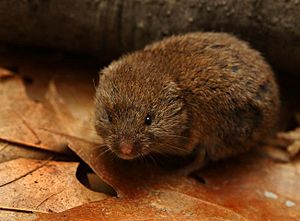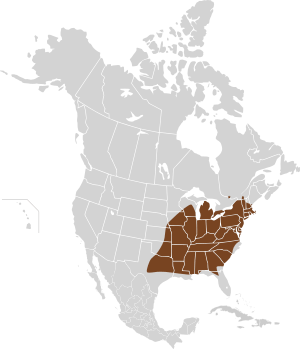Woodland vole facts for kids
Quick facts for kids Woodland vole |
|
|---|---|
 |
|
| Conservation status | |
| Scientific classification | |
| Genus: |
Microtus
|
| Species: |
pinetorum
|
 |
|
The woodland vole (Microtus pinetorum), also known as the pine vole, is a small rodent. You can find this little animal in the eastern part of North America.
Contents
Vole Features
The woodland vole is a small animal. Its head and body are about 3.25 to 4.75 inches (83–121 mm) long. It has a short tail, only about 0.5 to 1.5 inches (13–38 mm) long. A woodland vole usually weighs between 0.5 and 1.3 ounces (14–37 g).
Their fur is brown, either light or dark. Their belly is whitish or silvery. Their eyes, outer ears, and tail are small. These small features help them live easily in their underground homes.
Where Woodland Voles Live
Woodland voles live across the eastern United States. You can find them as far west as Nebraska, Kansas, Oklahoma, and Texas. They like to live in forests where trees lose their leaves in autumn. They also live in dry fields and apple orchards.
Voles prefer places with lots of plants, ground cover, and old fallen logs. Forests with moist, soft soil are great for digging burrows. Voles are most common in these areas. However, they can also live in dry fields or near coastal bays. Apple orchards are a favorite spot for them. Tree roots are an important food source. So, how trees are spaced affects how many voles live there.
Voles prefer soils that are easy to dig in. This includes mixtures of loam and peat moss, or even gravelly soils. They do not like very dry soils. Certain soil types, like Alfisol and Ultisol, are especially good. This is because they are perfect for the vole's burrow system.
What Woodland Voles Eat
Voles eat both the roots and stems of plants. They also eat other plant parts, fruits, seeds, and tree bark. Sometimes, they eat underground fungi and insects. Because they get a lot of water from roots and tubers, voles do not need to drink much water. They store food, especially during the winter months.
Voles spend most of their time underground. They live in their burrow systems. They rarely come to the surface. This helps keep them safe from predators like hawks and owls. Other animals that hunt voles include snakes, weasels, and mountain lions. Voles can also get tiny parasites like lice, fleas, mites, and chiggers.
Vole Families and Life Cycle
Woodland voles live in family groups. Each group has its own burrow system. These burrows are usually about 14.75 to 17.75 inches (40–45 cm) long. Each family group has its own burrows. Other voles usually do not try to take over these burrows.
A family group often includes a mother and father vole that breed. They also have 1 to 4 of their young. Sometimes, a few other voles join as helpers. These helpers usually come from other groups. It is rare for a vole to leave its group unless there is a space in another group. Staying in a group, even if not breeding, is helpful. Building burrow systems takes a lot of effort and they are a limited resource.
In the northern areas, voles breed from March until November or January. In the southern areas, they breed all year long. For a female to be ready to breed, she needs to sense special smells from a male. She also needs physical contact. It is rare for one male vole to have many partners. This is because female voles live spread out. The main breeding female in a group also tries to stop other females from breeding. Female voles are very loyal to their partners. They can be quite aggressive towards male voles they do not know. A young female vole usually has her first babies around 105 days old. But she can start as early as 77 days.
Pregnancy lasts about 20 to 24 days. A female vole can have 1 to 4 litters (groups of babies) each year. Each litter has 1 to 5 young voles. If a vole's partner dies, a new, unrelated vole will take its place. This can sometimes cause problems between the parent and its same-sex offspring. A new male in a group might give a non-breeding female a chance to have babies. However, the main breeding female is still a challenge.
Voles and People
Woodland voles can cause a lot of damage to apple orchards. This leads to big money losses for apple growers. Vole feeding costs apple growers nearly $50 million each year. Because of this, farmers often see voles as pests. Living near cities does not seem to affect where voles choose to live.
See also
 In Spanish: Microtus pinetorum para niños
In Spanish: Microtus pinetorum para niños


